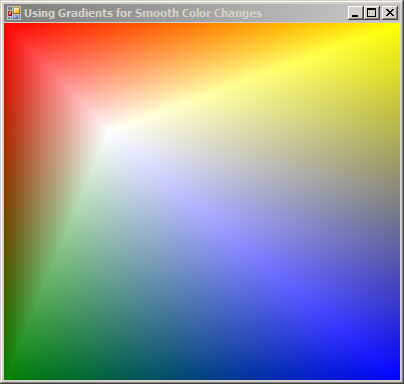
Imports System.Drawing
Imports System.Drawing.Drawing2D
Imports System.Windows.Forms
public class PathGradientBrushSurroundColors
public Shared Sub Main
Application.Run(New Form1)
End Sub
End class
Public Class Form1
Private MouseX As Integer
Private MouseY As Integer
Private Sub Form1_MouseMove(ByVal sender As Object, _
ByVal e As System.Windows.Forms.MouseEventArgs) _
Handles Me.MouseMove
MouseX = e.X
MouseY = e.Y
Me.Refresh()
End Sub
Private Sub Form1_Paint(ByVal sender As Object, ByVal e As System.Windows.Forms.PaintEventArgs) Handles Me.Paint
Dim thePath As New GraphicsPath
thePath.AddRectangle(Me.ClientRectangle)
Dim smoothBrush As PathGradientBrush = New PathGradientBrush(thePath)
smoothBrush.CenterPoint = New PointF(MouseX, MouseY)
smoothBrush.CenterColor = Color.White
Dim colorArray() As Color = {Color.Red, Color.Yellow, Color.Blue, Color.Green}
smoothBrush.SurroundColors = colorArray
e.Graphics.FillRectangle(smoothBrush, Me.ClientRectangle)
End Sub
End Class
<Global.Microsoft.VisualBasic.CompilerServices.DesignerGenerated()> _
Partial Class Form1
Inherits System.Windows.Forms.Form
'Form overrides dispose to clean up the component list.
<System.Diagnostics.DebuggerNonUserCode()> _
Protected Overrides Sub Dispose(ByVal disposing As Boolean)
If disposing AndAlso components IsNot Nothing Then
components.Dispose()
End If
MyBase.Dispose(disposing)
End Sub
'Required by the Windows Form Designer
Private components As System.ComponentModel.IContainer
'NOTE: The following procedure is required by the Windows Form Designer
'It can be modified using the Windows Form Designer.
'Do not modify it using the code editor.
<System.Diagnostics.DebuggerStepThrough()> _
Private Sub InitializeComponent()
Me.SuspendLayout()
'
'Form1
'
Me.AutoScaleDimensions = New System.Drawing.SizeF(6.0!, 13.0!)
Me.AutoScaleMode = System.Windows.Forms.AutoScaleMode.Font
Me.ClientSize = New System.Drawing.Size(396, 357)
Me.DoubleBuffered = True
Me.Name = "Form1"
Me.Text = "Using Gradients for Smooth Color Changes"
Me.ResumeLayout(False)
End Sub
End Class